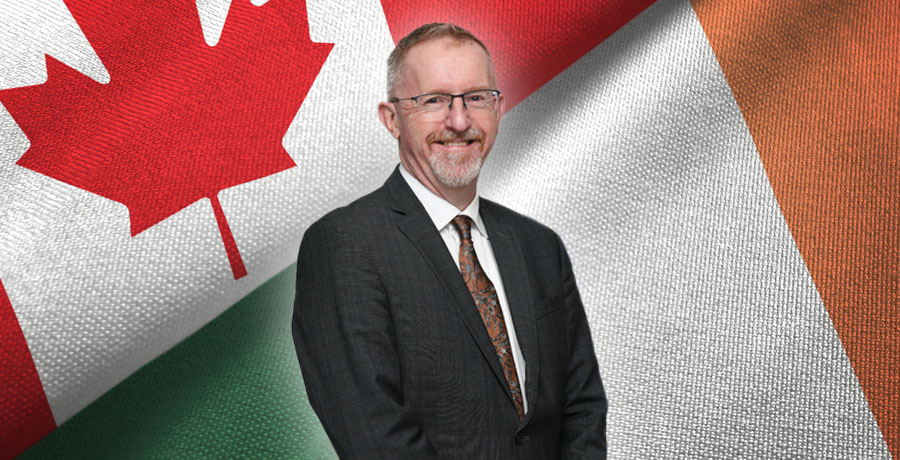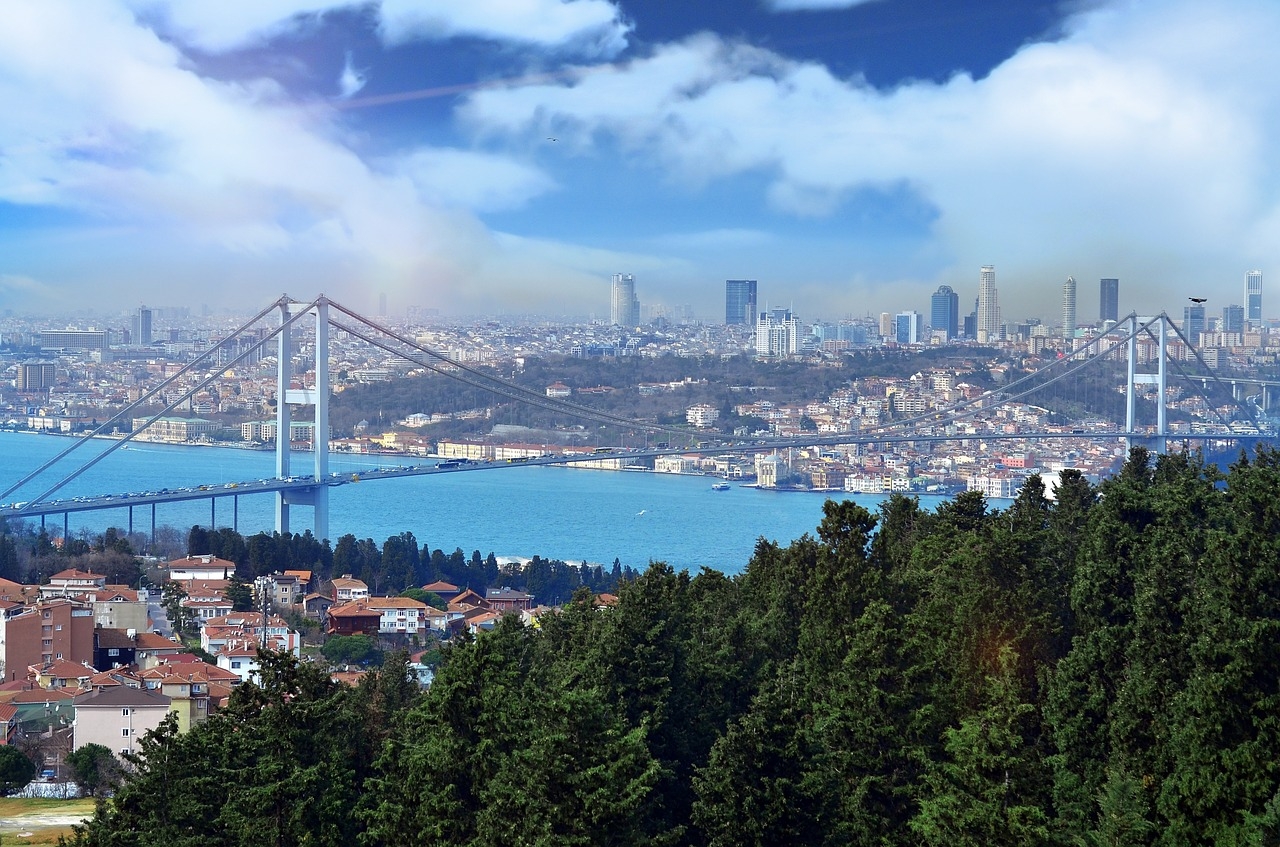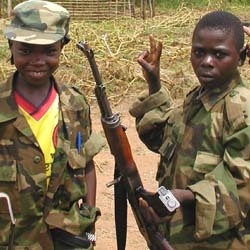
The Best Ships Are Friendships: Irish Ambassador Eamonn McKee on Diplomacy and the Utilities of History
Eamonn McKee is Ireland’s Ambassador to Canada, Jamaica, The Bahamas and just recently Antigua and Barbuda. (Ireland has a consulate-general in Vancouver and honorary consulates in Calgary, Edmonton, and St. John’s.)
He joined Ireland’s Department of Foreign Affairs in 1986, a year prior to graduating from the National University of Ireland in 1987, with a PhD that examined the intricacies of Irish economic policy from 1939 to 1952. Since then, McKee has been at the centre of some of the most transformative events in contemporary Irish history. He is one of the last Irish civil servants who participated in the historic Northern Ireland peace accord, the Good Friday Agreement, which set a new standard for conflict resolution and peacebuilding amongst nations.
McKee’s first posting was at the Irish Embassy in Washington between 1990 and 1996, where he met his wife Mary and two of their three children were born. A stint as a press officer followed at the Irish Consulate in New York between 1999 and 2001. In between, he was a member of the talks team involved in the negotiation of the Good Friday Agreement of 1998 and was later involved in its implementation. His focus was on the terms of reference for new policing in Northern Ireland. Later, he recruited Canada’s Supreme Court Justice Peter Cory to examine controversial killings in Northern Ireland. “This was a major step forward”, he says, “and Peter was one of the most extraordinary human beings I have met.” Since coming to Ottawa, he has become friends with General John de Chastelain, who did so much to take paramilitary guns out of Northern Ireland politics. “Canada’s contribution to our peace has been tremendous”, he adds. “We want Canada to stay engaged. The road to reconciliation is a long one, and we need friends like Canada.”
Roles followed as the head of the Justice and Security Section of the Anglo-Irish Division and as head of the Emergency and Recovery Section of Irish Aid in 2005. In 2006, he was appointed UN Director and Director of the Conflict Resolution Unit. In August 2009, he received his first post as an ambassador to the Republic of Korea and the Democratic People’s Republic of Korea. In 2013, he became Ambassador to Israel before returning to Dublin in 2015 to serve as Director of the Trade Division.
In addition to his ambassadorial duties, since arriving in 2020 as Ireland’s Ambassador to Canada, McKee’s diplomatic tenure has been marked by a profound engagement with Canada’s rich Irish heritage.
McKee, the diplomat, is knowledgeable, informed, and thoughtful. McKee, the historian, is a storyteller with an impressive grasp of global geopolitics, which he views through the lens of history. He can link lessons from the past with the present to explain some of the issues confronting Canada, Ireland and other nations today.
When asked about the overall state of the Canada-Ireland relationship, McKee’s instinctive response is focused on the shared values between Canada and Ireland, noting, “Canada and Ireland are steadfast advocates for the United Nations, champions of peacekeeping efforts, and proponents of the international order.” He adds, “Both countries are committed to advancing climate change and sustainable development goals, as well as championing gender equality and LGBTQ+ rights, and all those are good.”
Pivot to hot-button issues like Ukraine and Gaza, McKee is refreshingly candid. “The Russian invasion is an outrage, and the Irish government supports Ukraine’s territorial border.” When pressed about Ireland being militarily neutral in the conflict, Mckee nods and adds, “Yes, we are a neutral state, but we are not morally neutral.”
On Israel and Gaza
As a former Irish Ambassador to Israel (2013-2015), McKee knows the territory and issues very well. He condemns the October 7th attacks by Hamas and acknowledges the shock and anger of Israel, noting “that the criminals who undertook the attacks should be prosecuted at the International Criminal Court.” Yet the carnage inflicted on Palestinians in Gaza is shocking and must stop. “Israel must follow the rule of law and the rules of war,” he says. “The hostages must be released, and there must be a ceasefire to stop the destruction and deaths.” He notes Canada has called for the same.
On Canada-Irish Parallels: Housing, Immigration and Healthcare
Given that Ireland has housing and healthcare infrastructure and service delivery problems like Canada, I asked McKee if he sees any parallels or has any observations related to these issues. “The housing crisis in Western society has an exceptionally long arch. Most western governments under neoliberal policies stepped back from social housing at a cost,” says McKee. He observes that Ireland’s population of approximately five million has experienced “a lot of growth via immigration.” As the population ages, “we need immigrants for the labour market. There are challenges with any immigration process, but ultimately, new immigrants with their talents and energy are good for society.”
I pose a similar question on healthcare as both Canada and Ireland have public healthcare (Ireland has a dual healthcare system, consisting of both private and public healthcare options, with universal coverage for primary care). McKee cites the traditional role of the church in Ireland in delivering healthcare and notes that this was also present in Canada from its earliest days due to the influence of the church here with early settlers. “I think that healthcare in Ireland and Canada is deeply rooted in our history.” That complicated adjustments to modern medicine and public health care expectations. He adds, “Today, every country is dealing with healthcare policy – trying to strike a balance between those delivering services (doctors, nurses, etc.) and those in administration and the patients. It’s very challenging for governments – healthcare systems are constantly transitioning and working with new and seamless medical technologies to provide better care while grappling with legacy issues and new ways of thinking when it comes to healthcare service delivery and medicine. There are also other issues, like who gets what level of care, at what point, and so many others. But fundamentally, I think citizens of both our countries agree medical care is a moral right.”
On Irish Trade and Brexit
I turn to trade issues and how Ireland is dealing with Brexit. Since the Brexit referendum in 2016, Northern Ireland has been a focal point of concern due to its unique position within the United Kingdom, sharing a land border with the Republic of Ireland, an EU member state. The original Brexit deal, including the contentious Northern Ireland Protocol, aimed to prevent a hard border on the island of Ireland, preserve the Good Friday Agreement, and maintain peace and stability in the region.
McKee says the new Northern Ireland trade framework is “one of the most crucial agreements to emerge in the past decade between Ireland, Northern Ireland and the rest of the UK since the Good Friday Agreement. The key is that customs arrangements have been refined to strike a balance between maintaining the integrity of the EU’s single market and minimizing trade barriers within the UK internal market. The new deal is the result of challenging negotiations and has significant implications for businesses, communities, and political relationships throughout Ireland (North and South).”
McKee says the new deal “will further streamline trade procedures between Northern Ireland and the rest of the UK, reduce bureaucracy hurdles and ensure the continued smooth flow of goods across borders. He draws a comparison to NAFTA, saying, “The new (Irish) deal, like NAFTA, is one where the devil is in the details, but the overall policy should work because it includes provisions for continued cooperation between Northern Ireland and the EU in key sectors such as agriculture and manufactured goods.” He adds, “It also has a mechanism to provide democratic consent for the Protocol, ensuring that the people of Northern Ireland have a say in its implementation and future developments.”
McKee says that despite the deal, with Brexit, challenges remain. “Businesses and others will need to adapt to the new trade arrangements and regulatory requirements, which will take time. But overall, I think it is on the right path,” he says.
Ambassadorial Storyteller
It is rare to have an ambassador who doubles as a literary scholar and writer. That this person would be from Ireland is appropriate, given the Emerald Island’s penchant for producing great tales. Think of James Joyce, Yeats, Stoker or better still, Jonathan Swift with his satirical masterpiece A Modest Proposal, which skewered the British treatment of the Catholic Irish in the 18th century when outbreaks of famine were common. And, of course, one cannot mention these esteemed authors without mentioning Saint Patrick, the patron saint of Ireland — a fifth-century Christian missionary whose legacy transcends religious boundaries to become an enduring symbol of Irish culture and identity. He is credited with converting much of Ireland to Christianity and establishing monasteries, schools, and churches. (The most famous legend associated with Saint Patrick is his use of the three-leafed shamrock to explain the concept of the Holy Trinity).
It would also be remiss not to mention Irish authors today, including John Banville, fiction writer Louise O’Neill, or even Fintan O’Toole and his book We Don’t Know Ourselves: A Personal History of Modern Ireland. McKee reminds me of O’Toole in some ways — possibly because they have lived through the same things over the past four decades. Of course, it’s important for the credibility of this article that Bono and/or Sinead O’Connor are mentioned — you get the drift — these folks know how to bend a sentence and break a heart. And McKee is cut from the same storytelling cloth.
In addition to his duties as Ambassador to Canada, McKee has become a local expert in researching the stories about the lives and impact of Irish immigrants to Canada. He is quick (and proud) to point out their contributions in numerous fields, from politics and culture to business and jurisprudence. His insightful articles on Irish history have resonated deeply with the Irish diaspora in Canada, fostering a sense of cultural pride and heritage among Irish descendants.
A conversation about history, literature and politics with McKee is akin to watching a documentary movie unfold. His enthusiasm for Irish and Canadian history could be bottled and sold. His heartfelt history stories and anecdotes about Canada-Ireland links have been published in The Globe and Mail, the National Post and several writings on LinkedIn, including My First Impressions of Canada and a real insider gem about the Good Friday Agreement and peacebuilding in Northern Ireland.
In October 2022, McKee initiated the Fifty Irish Lives in Canada project with a group of the leading historians of the Irish in Canada to compile profiles of the lives of Irish-born people who made a contribution to Canada or lived lives emblematic of the Irish immigrant. It was, he said, an amazing journey of discovery. “You can’t throw a stone in Canada without hitting something Irish!” he says.
“It was inspired by the Royal Irish Academy’s publication, Irish Lives in America.” McKee points to Patrick Reid as one example of how Irish immigrants have contributed to Canada’s image in the world and to Canadians’ own self-understanding. As the story goes, in 1967, Prime Minister Lester Pearson had already laid the groundwork for a new Canadian flag. His preferred design of three red maple leaves over a white background, with blue bars at either end, was criticised by many as the “Pearson Pennant.” Pearson went to Belfast-born Reid, a civil servant and the head of the Canadian Government Exhibition Commission, who in turn assigned government artist Jacques Saint-Cyr to the project. The duo was indispensable in creating the stylized flag we have today. A detailed profile of Reid’s story can be found in the Fifty Irish Lives in Canada project.
His other writings on Canada and the Ottawa Valley are award-worthy for their detail, prose, and storytelling. His article Colonial Twins: Ireland, Canada, and the Great Irish Famine is superbly written and is a paint-by-numbers explanation of one of Ireland’s great tragedies with a Canadian hook.
McKee has an exceptional blog where he posts many of his stories and, at times, anecdotes that date back well over a decade. Exploring the complexity of Ireland’s engagement in the British Empire is a core theme, he notes, that needs to be more widely understood at home. The Irish in Canada is an entry point to this. “Unionists and nationalists have far more heritage in common than the sectarian force field of Northern Ireland has allowed”, he says.
One of the articles he shares is titled Kindred Spirits, written by Professor Mark McGowan, which tells the story of the Indigenous relief efforts on behalf of the Irish famine refugees. The Irish have a long memory, and the help provided by Indigenous communities has not been forgotten.
Over 150 years later, the Irish lacrosse team stood down to ensure the Iroquois national team from Canada could participate in the 2022 World Cup; Ireland’s Minister for Foreign Affairs facilitated the team’s entry on their Iroquois passports. The British government had refused to allow an Iroquois lacrosse team to travel to England in 2010 using passports issued by the Iroquois Confederacy.
“Mark’s research has also revealed something we did not know”, he says. “We were aware of individual cases of Canadians giving their lives helping the typhus-stricken Irish, some 100,000 of whom flooded Canada in 1847, the worst year of the Great Irish Famine. “Now we know that more than 80 gave their lives to help us.”
Extension of the National Famine Way Ireland, the Famine Emigrant Way (Canada)
As a tribute to honour Canadians and Indigenous people who provided care to Irish immigrants, their efforts will be recognised at the Irish Residence in Ottawa on April 11, 2024, as part of the National Famine Way project in Ireland, which commemorates the journey undertaken by 1,490 famine emigrants who walked from Strokestown, County Roscommon, to ships in Dublin Port during the Irish Famine of the 1840s. The 165 km has been transformed into a modern-day trail that follows the footsteps of those who endured this arduous journey. The route is marked by over thirty casts of Bronze Shoes markers based on a pair retrieved from the thatched roof of a 19th-century cottage. Interpretive panels provide historical context, offering a poignant reminder of this tragic period in Irish history.
Ambassador McKee and his team are planning to extend the heritage trail to Canada, following the immigrants’ onward journey to build new lives and success here. The Famine Emigrant Way will be marked by the same Bronze Shoes.
The Strokestown tenants were part of 106,000 Irish emigrants who fled during the famine. Twenty percent died on the journey: the two main burial sites are the quarantine station at Grosse Île (5,400 remains) and at Blackrock Montreal (6,000). Other burial sites are located at Toronto and Kingston (around 1,000 each), Partridge Island (600), Middle Island (96), New Brunswick (600), Ottawa (300), Cornwall (50) and elsewhere.
The cargo of Bronze Shoes will be transported from Galway on board the Irish exploration vessel, the Celtic Explorer, arriving at St John’s, Newfoundland and Labrador on May 9, 2024. The Bronze Shoes will be carried ceremoniously to St John’s Basilica for viewing. Bronze Shoes will be transported up the St Lawrence to Quebec City for installation there and at Grosse Île. Plans are afoot to bring the Bronze Shoes to Ottawa this summer. Other sites will be added to the Famine Emigrant Way in future years.
Information panels and related social media are being developed by the National Famine Museum for use in Ireland and Canada. (To receive a set of Bronze Shoes, local organisations must enter into a legal agreement with an authority to maintain the marker, erect a plinth and install a QR code with relevant background and a link to the National Famine Way website.)
Ambassador McKee says the Bronze Shoes project will further deepen the links between Ireland and Canada and promote our shared heritage. “It’s an opportunity to thank Canada for their response to the Irish humanitarian disaster and to recognise the heroic efforts Indigenous people and other first responders who helped the Irish immigrant.” McKee adds that, “it also recognises how the eighty percent of Irish who survived and prospered in their new home. There is a universal message in offering hope through compassion and success through opportunity to the stranger on your shore.”
Canada-Irish History Remains Largely Untold
The presence of the Irish in Canadian history stretches back to the arrival of John Cabot in Newfoundland in the fifteenth century. It’s estimated that as many as four million Canadians claim Irish ancestry, a lineage that extends even into the Francophone community of Quebec. From early settlements in Atlantic Canada and Quebec to the influx spurred by the 1840s famine, the Irish have woven themselves into the fabric of Canadian life.
Despite significant contributions, the full extent of the Irish impact on Canadian society remains underexplored. Historical records regarding Irish heritage in Canada are often elusive, leaving gaps in our understanding of the pivotal role of the Irish in Canada. The profound influence of people like Guy Carleton (1724-1808), Thomas D’Arcy McGee (1825-1868), Timothy Eaton (1834-1907), Robert Samuel McLaughlin (1871-1972), Nelly McClung (1872-1951) and Cardinal J. C. McGuigan are just some of the forebears who played a hand in shaping Canada.
Irish Ambassador Eamonn McKee has made significant strides in bridging this knowledge gap during his tenure in Canada, and for that, we are thankful.









